Yacon is closely related to Jerusalem artichoke. You can find out here how to grow, care for and use the sweet tuber in your own garden.

You have never heard of Yacon (Smallanthus sonchifolius) heard? Then it's about time. The super tuber is full of good ingredients, has few calories and is even said to help you lose weight. In terms of taste, it can be compared to pears or melons. Yacon is still relatively unknown to us, but with the right hand movements it can also grow in your garden. We'll tell you the best varieties of yacon, what to look for when buying, how to best grow the tuber in your garden and how to use the yacon root.
contents
- Yacon: origin and characteristics
- Yacon varieties
- Buy Yacon
-
Planting yacon
- Prefer yacon in the pot
- Planting yacon: location and requirements
- Planting yacon: instructions
- Propagate yacon
-
Maintain Yacon
- Pour yacon
- Fertilize yacon
- Harvest and store yacon
- Yacon: ingredients and uses
- Yacon: Common Diseases and Pests
Yacon: origin and characteristics
Yacon comes from the Andes highlands and was already valued as a medicinal and useful plant by the Inca. In the meantime, Yacon is no longer only cultivated in South America, but also in Asia, Oceania, the USA and Europe. It belongs to the sunflower family (Asteraceae or Compositae), so the yellow flower resembles the Sunflower (Helianthus annuus). The plant is herbaceous and can grow up to two meters in height. In its tropical home, the plant is perennial, but since it cannot tolerate frost, it has to be stored as a rhizome here in winter. Closely related to Jerusalem artichoke (Helianthus tuberosus) and sweet potato (Ipomea batata) the root tubers are also edible at Yacon. Compared to sweet potatoes, these are not floury, but crunchy and fresh and taste fruity-sweet.

Yacon varieties
There are many different types of Yacon, but only a limited number are currently available in Germany. The main difference between the yacon bulbs is their color and sweetness. The color of the roots ranges from almost white to light brown to purple to dark red. The color of the tubers depends on the variety. Another difference between the varieties is the sugar content. The yacon tubers contain a lot of fructooligosaccharides, a type of sugar that makes the tubers very sweet. Because of its sweetness and fruity taste, the Incas also called their yacon root "fruit that grows underground". Depending on the variety, the tubers can be less sweet to very sweet. The following varieties can all be grown in German climatic conditions.
‘Bekya’: The variety is characterized by early flowering and high yield. The tubers have a brownish skin and white flesh. ‘Bekya’ is one of the less sweet yacon varieties.
'Morado': The yacon variety ‘Morado’ is already widespread in Germany. The tubers are purple and very sweet.
‘Cajamarca’: This variety is characterized by a high yield. The tuber color is reddish to purple.
"Quinault": The yacon variety ‘Quinault’ flowers early and has a high sugar content. The tubers are purple.
Buy Yacon
Since this is a relatively new vegetable, it can't be that easy to buy Yacon. Yacon for your own garden can be bought as a plant or a rhizome (ground sprout). Both are available from specialized online retailers. When deciding whether young plants or rhizomes are preferred, the following must be taken into account: Early plants have a head start on the rhizomes in spring and grow more quickly. However, compared to the rhizomes, the plants are usually more expensive and more sensitive to shipping. Since you can prefer the rhizomes to young plants, we recommend buying Yacon rhizomes.

If you find yacon tubers in the store or at the weekly market, you can only eat them, not plant them. The plant develops two different types of roots: the edible tubers, which serve as storage organs, and the rhizomes for reproduction. Yacon can only be propagated through the rhizomes. The good news is that you only need to buy yacon for the first year of growing, as the tuber is easy to grow yourself. You can find more about this in the chapter "Propagating Yacon".
Tip: If you bought the rhizome through an online retailer, check the condition upon receipt. It is often the case that the rhizomes have become somewhat rubbery and may have grown during transport. Soak the rhizomes in room temperature water for about 8 hours, then they should set again. Then put them in sand or potting soil without fertilizer. At a temperature below 10 ° C, the rhizomes can be stored well until the time of planting.
Planting yacon
Yacon is very sensitive to frost. Planting too early does not pay off: If the young plants or roots are caught in the frost, they are severely damaged. You should therefore wait until after the ice saints (mid-May) to plant to make sure that your yacon is not damaged by frost. The rhizomes can either be planted directly in the garden or grown in pots.
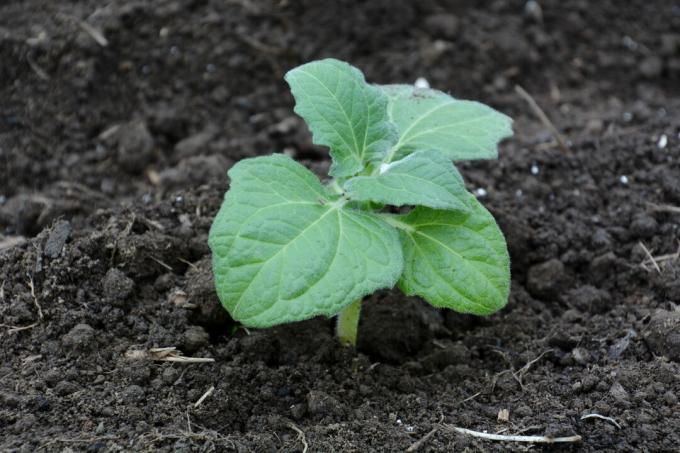
Prefer yacon in the pot
By preferring your yacon in pots, you can give it a big head start. You can start about two months before you expect the last frost. If the last frost is expected around mid-May, you can start growing in the pot in mid-March. Make a 3 to 5 cm deep hole and place the rhizome piece with the cut side down and the buds up. Then cover it with soil and water it. The pot can stand on the windowsill or in a heated greenhouse. If the temperatures outside no longer fall below freezing point, the young plants can be planted in the garden.
Planting yacon: location and requirements
Yacon makes no great demands on its location as long as it doesn't freeze. The tuber thrives best on light, sandy soils. Yacon doesn't like waterlogging at all. Yacon prefers to stand in sunny places where the sun shines on it from morning to evening. Since the plants can grow up to 2 meters in height, a sheltered location is advisable. In terms of nutritional requirements, Yacon is very frugal. It needs little nitrogen and phosphorus, but there should be enough potassium in the soil.
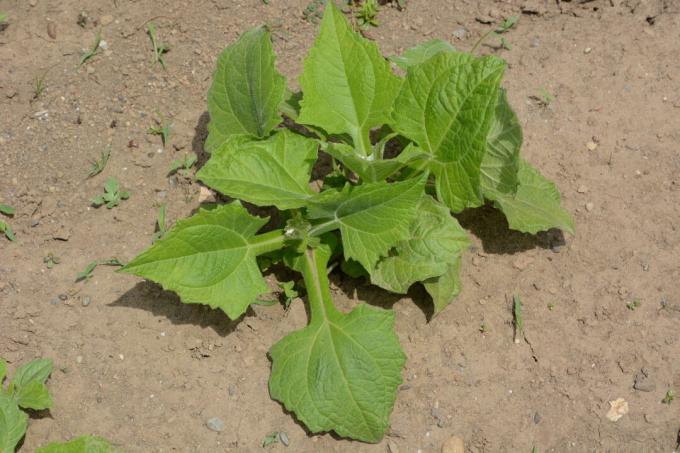
Yacon's location requirements at a glance:
- Sunny all day
- Sheltered from the wind
- Light, well-ventilated soils
- No waterlogging
- Low nutritional requirements
Planting yacon: instructions
If the rhizomes are planted directly in the garden, proceed as follows:
Loosen the earth well. If the soil is too compact and firm, sand can be worked into the soil. Do you like to work too? compost into the soil, as Yacon is happy about a high proportion of organic material. The rhizomes should be set about 5 to 10 cm deep in the ground. To do this, a hole is dug and the rhizome is placed in the hole with the cut side down and the seedling up. Fill the hole with the excavated material and water it well.
If you have preferred your Yacon in the pot, carefully remove the root ball of the young plant from the pot. Then carefully loosen the root ball. The soil should also be well loosened and enriched with compost. The young plant is then placed in a prepared hole and well watered. A planting distance of at least 80 cm is recommended in the row. There should be at least a meter of space between the rows.

Regardless of whether you are planting a rhizome or a young plant: Both are happy about a layer of mulch. For mulching, you can use organic material such as leaves, bark mulch or lawn clippings. The germs of the rhizome can easily grow through a layer of mulch. In the young plant, the mulch is carefully distributed around the plant. This protects the soil from drying out and suppresses weeds.
Yacon can also be grown in a bucket. Please note that the plant becomes very large and forms a lot of leaf mass. A large pot is essential, otherwise the harvest will be disappointing. It is best to use a bucket for Yacon that can hold around 75 liters.
Tip: Yacon grows slowly after planting. So it can take several months before enough leaf mass is formed and the ground is covered. At this stage, the uncovered soil offers the best conditions for unwanted weeds. One way to counteract this is to plant Yacon in mixed cultures. To do this, choose plants that are fast growing and harvested before the yacon plant gets too big. Salads, radishes or turnips are ideal for this.
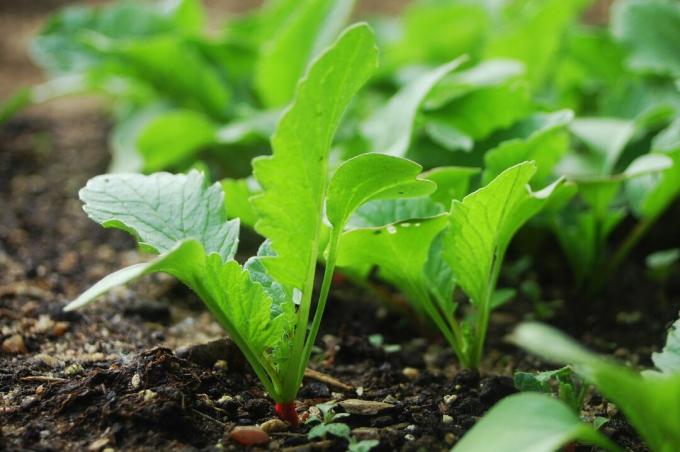
Planting Yacon Summary:
- Select a sunny, sheltered location
- Loosen the soil well, mix in straw if necessary
- Work compost into the soil
- Dig a 5-10 cm deep hole
- Put the rhizome or young plant in it
- Fill the hole with excavated material
- Water well
- Spread the mulch layer
- Plant spacing: min. 80 cm between plants; at least 1 meter between rows
Propagate yacon
Yacon forms two types of storage organs: large storage roots suitable for consumption and rhizomes. You can cut these rhizomes into many smaller pieces. When cutting a yacon rhizome, it is not uncommon to get 20 or more pieces of rhizome that can be individually planted into a new yacon plant. The rhizome should be divided so that it can later sprout when planted. To do this, it is best to cut it into pieces, where there should be at least 2 nodes, better even 5.
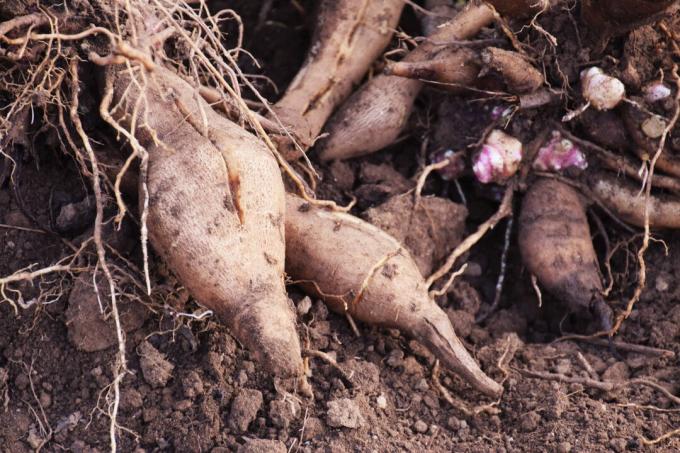
The following is recommended for storing the rhizomes: Store the rhizome crowns as a whole. So don't cut them open before you start planting. Cut rhizomes allow the individual pieces to dry out faster. Do not remove all of the storage roots from the crown, but leave some of the small ones hanging. This improves the shelf life considerably.
Store the crown in dry sand or earth at around 4 ° C. It is important that the temperature never falls below freezing point. You don't have to water the rhizome crown. If the crown gets wet, it will sprout or rot. But it shouldn't dry out completely either. In the best case scenario, you should therefore store them in a place with high humidity. The rhizome crowns last about six months under the recommended storage conditions.
Maintain Yacon
Once your Yacon is planted, it actually grows by itself. Little maintenance is required. Right after planting, you should weed regularly to prevent weeds from spreading. As the plant grows, it develops very large leaves. Then weeding is no longer necessary. In addition to large leaves, Yacon is a very large plant overall. In German gardens, Yacon can grow up to two meters tall. You should therefore support particularly large plants. If stems break, the broken stems provide entry points for diseases and pests. If some tubers grow out of the ground, cover them with soil again. Otherwise, the tubers above the ground are a popular food for snails and other wolverines.

Pour yacon
In Quechua, the language of the Incas, Yacon means "water tuber". On the one hand, because a lot of water is stored in the tuber, on the other hand, because Yacon needs a lot of water to grow. The water is stored in the tuber, and the large leaves offer plenty of space for evaporation. So adequate watering is very important. After planting, it should be watered regularly, at the latest whenever the top layer of soil has dried off. As the plant grows and forms more and more leaf mass, the need for water also increases. If the summer is hot and it hardly rains, it may have to be watered every day. If Yacon is not supplied with sufficient water, this quickly has a negative effect on the tuber formation. If Yacon is grown in a bucket, watering is particularly important. It is best to check the soil's moisture every day. There should be no waterlogging, but if you water the yacon plant in the morning in summer, water can remain in the saucer. However, the plant should have used up the water by evening. You can then slowly reduce watering in autumn.
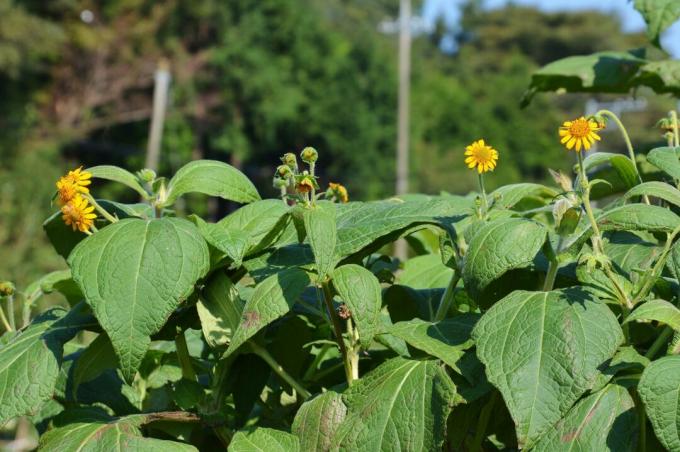
Fertilize yacon
Yacon is a heavy consumer of potassium, so it benefits from high-potassium fertilizers. However, you should be careful with excessive amounts of nitrogen, because too much nitrogen can restrict the root growth of Yacon. If the soil has been enriched with compost before planting, nitrogen no longer needs to be applied. The plant's phosphorus requirement is rather low and can be covered with long-term organic fertilizers. We recommend ours for fertilizing your Yacon plants Plantura organic universal fertilizer, which ideally covers the nutritional requirements of the super tuber.
Harvest and store yacon
Depending on the climate, the harvest time for Yacon varies from mid-October to mid-November. In light frost, the leaves of the yacon plant begin to die off and dry up. When the signs of leaf senescence are clear, the tubers are ready to be harvested. Yacon can be dug up with a spade or garden fork. Even with very careful digging, bulbs are likely to break off occasionally, which cannot be avoided. Once the root balls are dug up, remove the larger storage roots, leaving the smaller ones stuck to the rhizome. Tubers and rhizomes can be sprayed clean with a hose and then left to dry. The tubers and rhizomes should dry well so that no mold or rot can form.

The rhizomes are dried and stored as described in the chapter "Propagating Yacon". The tubers should be stored in a cool and dry place. The longer the tubers are stored, the more the fructose content increases and they become sweeter. Immediately after harvest, Yacon has a very mild, watery taste. The full aroma only develops after a long period of storage. The tubers can be placed in sunlight to speed up the ripening process. However, yacon tubers should not dry out during storage. To prevent this, you can put a bowl of water next to the stored harvest and refill it regularly. Alternatively, you can also store the tubers in containers with sand, this also prevents them from drying out. If stored carefully, the tubers often last up to nine months.
Yacon: ingredients and uses
The yacon tuber consists mainly of water and carbohydrates. Although 80% of the tasty roots are made up of carbohydrates, these are mainly indigestible sugars. Inulin and fructooligosaccharides are sugars that cannot be digested by humans. These sugars are said to reduce the feeling of hunger, stimulate the metabolism and promote a healthy intestinal flora (hence the claim that Yacon can help you lose weight). Overall, the tuber contains very few calories: Freshly harvested yacon has around 15 calories per 100 g. During storage, the tuber converts the indigestible sugars into fructose, and the calorie content rises to a still very low 22 calories per 100 g. Other ingredients of Yacon are calcium, phosphorus and vitamin C in small amounts. Like its brother Jerusalem artichoke, yacon can be eaten raw. But Yacon is also well suited for cooking, and its mild sweetness makes it compatible with many different flavors. Even with long cooking times, it stays relatively firm and crunchy. Try yacon in stir-fries, soups and stews, curries or as chips.
Yacon syrup
A common use of yacon is yacon syrup. This can be used as a sugar substitute such as agave syrup for sweetening. The advantage of yacon syrup over conventional sugars is that it is high in content Has fructooligosaccharides that cannot be digested and will prevent blood sugar levels from rising leaves.

To make yacon syrup, the tubers must be juiced in a juicer or a juicer. The yacon juice obtained is then filtered and boiled down until it has the consistency of syrup. The syrup can then be used to sweeten desserts and drinks, for baking and for cooking.
Yacon: Common Diseases and Pests
If you discover holes and feeding points in the leaves of your Yacon plants, this is an indication that your Yacon has been infected by pests. Snails feast on the young leaves of the plant and should therefore be collected regularly. The European corn borer (Ostrinia nubilalis) cause. This causes feeding damage to the stem until the stems break. The corn rootworm (Diabrotica virgifera) can damage the tuber. Even Voles every now and then you can taste the yacon tubers.

To prevent pest infestation, you should change the location of your Yacon every year so that pests cannot establish themselves. Diseases that can affect the yacon plant are Fusarium mushrooms at the roots and mildew on the leaves. To protect the plants from fungal diseases, it is important to keep the planting spaced wide so that the air can circulate well between the plants. Once the plant is infected, it can be treated with a biological anti-fungal agent. We recommend that you keep Yacon away from it Jerusalem artichoke or sunflowers to plant as these can be plagued by the same diseases and pests.



